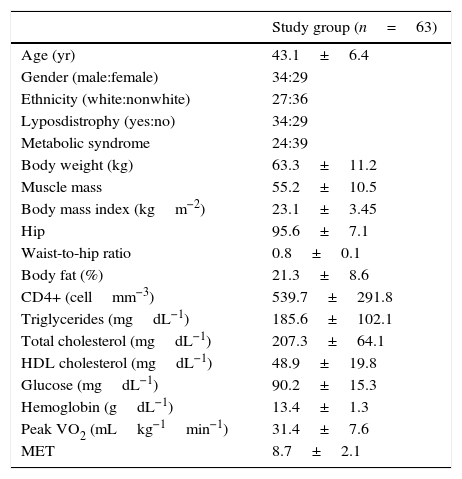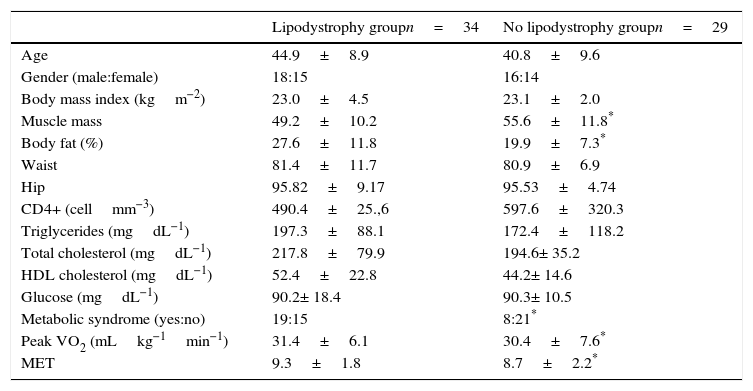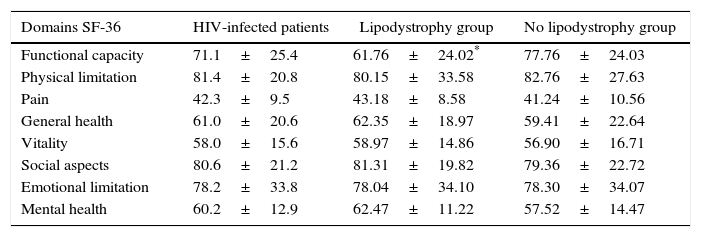HIV infection and its therapy which can affect their aerobic capacity and health-related quality of life of patients.
ObjectiveWe conducted a cross-sectional study to determine if aerobic capacity and health related quality of life was decreased in HIV-infected patients receiving highly active antiretroviral therapy and comparing patients with and without lipodystrophy.
Research design and methodsHIV-infected patients older than 18 years, and in current use of highly active antiretroviral therapy drugs, were evaluated for blood count, fasting total cholesterol, high density lipoprotein, triglycerides, glucose, HIV viral load and CD4/CD8 counts, body composition, peak oxygen consumption (peak VO2) and metabolic equivalent. Health related quality of life was assessed by using Short Form-36 (SF-36). Statistical analysis was carried out using SPSS version 20.0.
ResultsA total of 63 patients with mean age of 43.1±6.4 years were evaluated, of these 34 (54%) had lipodystrophy. The average peak VO2 (31.4±7.6mLkg−1min−1) was significantly lower (p<0.01) than expected values (37.9±5.6mLkg−1min−1) according to the characteristics of the patients. The lipodystrophy group presented with a significant difference in muscle mass, body fat, peak VO2 and metabolic equivalent and in functional capacity domains of SF-36.
ConclusionAerobic capacity values were reduced in HIV-infected patients under highly active antiretroviral therapy when compared to predicted values. Lipodystrophy was associated with reduced aerobic capacity and higher frequency of metabolic syndrome. Lifestyle modification should be a priority in the management of chronic HIV disease.
HIV-infected individuals are living longer in the era of highly active antiretroviral therapy (HAART). However, recent reports suggest increased rates of cardiovascular risk,1,2 body fat changes (lipodystrophy),3 and long-term adverse effects such as changes in physical functioning, disabilities and health-related quality of life (HRQOL) are common findings in this population.4
Functional impairment is common among HIV-infected persons. HIV-related disability has been associated with decrease in exercise capacity and patient's daily activities.5,6 Reduced aerobic capacity or cardiovascular fitness may contribute to further physical impairment and activity limitations, placing HIV-infected patients at risk for poor health outcomes.7–9 Some studies have shown an association between cardiovascular fitness and cardiovascular mortality, as well as all-cause mortality in men and women of all ages.10,11
Dependence on assistance with activities of daily living and/or reduced recreational activities participation may be associated with a lower HRQOL and higher risk of mortality.12 However, conflicting results have been reported in regard to aerobic capacity. Some authors have reported reduced aerobic capacity in HIV patients in HAART use,5,6,12,13 whereas others have detected no adverse long-term effect.14,15
The measure of peak oxygen consumption (peak VO2) has been utilized to assess aerobic capacity as well as for the prescription of exercise programs in this population.16 HRQOL is one of the most utilized subjective aspects in evaluating the impact of chronic diseases and both its definition and assessment are contentious.17,18 The combination of negative effects on physical and mental function in HIV-infected patients with lipodystrophy may have a further adverse impact on HRQOL, but its impact on aerobic capacity and quality of life has not been properly studied. The objective of this study was to determine if aerobic capacity and quality of life was diminished in HIV-infected patients receiving HAART and if lipodystrophy was related to these outcomes.
MethodsPatients and settings. The study was conducted at the AIDS Clinics of Federal University of Bahia Hospital (HUPES), a public HIV referral service in Salvador, Brazil. The project was approved by the Institutional Ethics Research Committee.
Study design: We conducted an observational cross-sectional study. Patients were consecutively invited to enter the protocol following the signature of an informed consent. The inclusion criteria were: current use of ARV drugs, age equal or higher than 18 years, and availability to attend the study activities. Exclusion criteria included pregnancy, active opportunistic infections and history of regular exercising before entering the study.
MeasuresLaboratory measurements consisted of total cholesterol, HDL, triglycerides, glucose, HIV viral load and CD4/CD8 counts. Metabolic syndrome was defined following National Cholesterol Education Program Adult Treatment Panel III definition.19 Based on that definition, three or more of the following criteria need to be met for defining metabolic syndrome: (1) fasting serum triglycerides ≥150mg/dL; (2) abnormal waist circumference: waist perimeter ≥102cm in man, or ≥88cm in women; (3) fasting blood glucose ≥100mg/dL; (4) hypertension: systolic blood pressure ≥130mmHg and/or diastolic blood pressure ≥85mmHg, and/or use of an antihypertensive drug; (5) low HDL-cholesterol: ≤40mg/dL for men, or ≤50mg/dL for women.
We measured weight, height, body mass index (BMI) and skin fold. Body weight was measured using a balance accurate to 100g. Height was measured by a stadiometer with subjects barefoot. BMI was calculated by dividing body weight (kg) by height squared (m2). We used the digital caliper to evaluate the percentage of lean body mass, fat mass, and muscle mass. The calculation was based on Faulkner's skinfold protocol.20 In addition, we measured the circumference of chest, waist, waist-hip ratio, abdomen, hips, forearms, arms, thighs and calves (0 and 6 months). The measurement was performed with the patient standing upright, using a flexible tape measure and extendable to one decimal place.21,22
Lipodystrophy was defined clinically by physical examination and by patient report of fat wasting in the face, arms or legs with or without central obesity. Patients were initially asked a general question about any changes in body appearance, followed by questions with specific reference to the regions mentioned above, time of onset of changes in each region, and whether the changes had resolved. Patients with weight change but without peripheral fat loss were not defined as having lipodystrophy.23
The exercise testing was performed to evaluate the clinical response, the hemodynamic, electrocardiographic and metabolic stress, and to customized exercise prescription and subsequent evaluation of therapeutic intervention, under the supervision of a cardiologist. We used the ergometer treadmill. We chose ramp protocol for the study. Subjects were exercised on a motor-driven treadmill with an initial speed of 3kmh−1 and a 2% incline. We used continuous increments in speed and incline, following a ramp protocol adjusted to the subjects’ predicted functional capacity, to reach volitional fatigue in approximately 8–12min. Blood pressure was measured every 3min using a standard arm sphygmomanometer, while 12-lead ECG was continuously monitored.24,16 The values of the test performed were compared with the predicted values in accordance with Jones equation for the treadmill test (VO2 predicted for male subjects=[60.0−(0.55×age)]×1.11; and VO2 predicted for female subjects=[48.0−(0.37 age)]×1.11).16
Assessment of quality of life was performed by applying the SF-36 (Medical Outcomes Study 36-Item Short-Form Health Survey). The SF-36 questionnaire contains 36 questions that are grouped into eight domains: functional capacity, limitations related to emotions, and perceptions of mental health, whose scores range from 0 to 100, where zero corresponds to the worst general state of health and 100 to the best state, meaning that the higher the total score, the better the perception of quality of life. This tool was already validated for use in Brazilian patients.25
Statistical analysisData of continuous variables were analyzed by using measures of central tendency and dispersion, and expressed as mean and standard deviation. Categorical or dichotomous variables were analyzed by using measures of frequency. We performed statistical tests Shapiro–Wilk to evaluate normality for all variables. Student's t test or Mann–Whitney test were used to compare the mean differences of variables between the liposdystrophy occurrences. Chi-square test was used to compare proportions. All p values were 2-tailed, and statistical significance was set at .05. All calculations were performed with Statistical Package for Social Sciences – SPSS version 20.0.
ResultsA total of 70 patients were invited, however seven patients did not attend the evaluations. Sixty-three evaluated patients had mean age of 43.1±6.4 years. Table 1 shows the demographic and clinics characteristics of patients in the study.
Demographic and clinics characteristics of the HIV infected patients included in study.
| Study group (n=63) | |
|---|---|
| Age (yr) | 43.1±6.4 |
| Gender (male:female) | 34:29 |
| Ethnicity (white:nonwhite) | 27:36 |
| Lyposdistrophy (yes:no) | 34:29 |
| Metabolic syndrome | 24:39 |
| Body weight (kg) | 63.3±11.2 |
| Muscle mass | 55.2±10.5 |
| Body mass index (kgm−2) | 23.1±3.45 |
| Hip | 95.6±7.1 |
| Waist-to-hip ratio | 0.8±0.1 |
| Body fat (%) | 21.3±8.6 |
| CD4+ (cellmm−3) | 539.7±291.8 |
| Triglycerides (mgdL−1) | 185.6±102.1 |
| Total cholesterol (mgdL−1) | 207.3±64.1 |
| HDL cholesterol (mgdL−1) | 48.9±19.8 |
| Glucose (mgdL−1) | 90.2±15.3 |
| Hemoglobin (gdL−1) | 13.4±1.3 |
| Peak VO2 (mLkg−1min−1) | 31.4±7.6 |
| MET | 8.7±2.1 |
Treadmill testing results showed a mean peak VO2±SD of 31.4±7.6mLkg−1min−1. The average peak VO2 was significantly lower (p<0.01) than expected values (37.9±5.6mLkg−1min−1) according to the Jones equation.16
Patients were stratified by elapsed time since HIV diagnosis (±5 years). No differences were found for demographic characteristics and age (p>0.05). The time since HIV diagnosis was also a factor that influenced the aerobic capacity of the patients. Patients with more than 5 years since diagnosis of HIV infection showed lower aerobic capacity than patients with less than 5 years of HIV (30.3±7.5 versus 34.7±7.02mLkg−1min−1, p=0.04).
54% of the patients had lipodystrophy. Demographic variables were comparable between groups with and without lipodystrophy.
Lipodystrophy group presented with a significant difference in muscle mass, body fat, peak VO2 and MET compared with patients without fat changes. This indicates that patients with lipodystrophy have less muscle mass and aerobic capacity in addition to a higher percentage of body fat. Table 2 displays demographic characteristics of patients according to the occurrence of lipodystrophy.
Demographic and clinics characteristics of patients with lipodystrophy compared with no lipodystrophy.
| Lipodystrophy groupn=34 | No lipodystrophy groupn=29 | |
|---|---|---|
| Age | 44.9±8.9 | 40.8±9.6 |
| Gender (male:female) | 18:15 | 16:14 |
| Body mass index (kgm−2) | 23.0±4.5 | 23.1±2.0 |
| Muscle mass | 49.2±10.2 | 55.6±11.8* |
| Body fat (%) | 27.6±11.8 | 19.9±7.3* |
| Waist | 81.4±11.7 | 80.9±6.9 |
| Hip | 95.82±9.17 | 95.53±4.74 |
| CD4+ (cellmm−3) | 490.4±25.,6 | 597.6±320.3 |
| Triglycerides (mgdL−1) | 197.3±88.1 | 172.4±118.2 |
| Total cholesterol (mgdL−1) | 217.8±79.9 | 194.6± 35.2 |
| HDL cholesterol (mgdL−1) | 52.4±22.8 | 44.2± 14.6 |
| Glucose (mgdL−1) | 90.2± 18.4 | 90.3± 10.5 |
| Metabolic syndrome (yes:no) | 19:15 | 8:21* |
| Peak VO2 (mLkg−1min−1) | 31.4±6.1 | 30.4±7.6* |
| MET | 9.3±1.8 | 8.7±2.2* |
In lipodystrophy group, 56% of patients had a previous diagnosis of metabolic syndrome (56%) versus only 27% in the group without lipodystrophy (p<0.05).
Table 3 shows the results of HRQOL of patients according to the presence of lipodystrophy. The domains of SF-36 that had lower values were pain, vitality, general health and mental health. Considering the HRQOL among patients with and without lipodystrophy only the domain functional capacity presented reduction in the group with lipodystrophy compared with no lipodystrophy.
Quality of life of HIV-infected patients included in study and with lipodystrophy compared with no lipodystrophy.
| Domains SF-36 | HIV-infected patients | Lipodystrophy group | No lipodystrophy group |
|---|---|---|---|
| Functional capacity | 71.1±25.4 | 61.76±24.02* | 77.76±24.03 |
| Physical limitation | 81.4±20.8 | 80.15±33.58 | 82.76±27.63 |
| Pain | 42.3±9.5 | 43.18±8.58 | 41.24±10.56 |
| General health | 61.0±20.6 | 62.35±18.97 | 59.41±22.64 |
| Vitality | 58.0±15.6 | 58.97±14.86 | 56.90±16.71 |
| Social aspects | 80.6±21.2 | 81.31±19.82 | 79.36±22.72 |
| Emotional limitation | 78.2±33.8 | 78.04±34.10 | 78.30±34.07 |
| Mental health | 60.2±12.9 | 62.47±11.22 | 57.52±14.47 |
Our results demonstrate that aerobic capacity values were reduced in HIV-infected patients under HAART when compared to predicted values. The prevalence of lipodystrophy in this study was 54%. Patients with lipodystrophy exhibited a significant reduction in muscle mass and aerobic capacity compared to those without such fat changes.
In a systematic review of Brazilian studies on lipodystrophy, the weighted average of the prevalence of lipodystrophy in people living with HIV was 53.5%26 and physical activity was considered an independent protective factor against the onset of HIV-associated lipodystrophy.
Several possible mechanisms for decline in aerobic capacity and activity limitation in people with HIV have been reported. Comorbidities that may be associated with the use of HAART such as congestive heart failure, coronary artery disease, peripheral vascular disease, and stroke may lead to a loss of physical function.27 As a result of associated comorbidities and related phenomena (such as loss of lean muscle mass and pain), individuals often reduce their physical activities, which may further decrease tolerance to exercise and quality of life.28
Structural and inflammatory muscle abnormalities which may impair the muscle's ability to extract or utilize oxygen during exercise also can also be associated with the physical limitation. Raso et al.15 observed that poor muscle strength is observed in some HIV/AIDS patients, which is associated with lower anaerobic power and peak oxygen uptake (peak VO2). However, the peak VO2 of physically active HIV patients does not differ from that observed in controls of similar age and with similar physical activity patterns.15
Røge et al.29 have identified that the significantly lower working capacity and the trend toward reduced peak VO2 in HIV-infected patients with lipodystrophy could be caused by mitochondrial dysfunction, but may also be caused by impaired physical fitness caused by underlying chronic disease.
In study performed for Zonta et al.,30 among the 120 HIV-infected patients, 85% reported impaired physical activity, 70% of the patients complained about various degrees of weakness, 50% stated that they performed all of their regular activities, although at a slower pace, with pauses for resting; 42% admitted that they had problems in making larger efforts and 8% felt like lying in bed. Functional status and the disability evaluations were associated with alterations in muscular strength.
Physiological deconditioning also may play a role in activity intolerance in HIV-infected patients, but this fact alone could not have fully accounted for the severity of the limitation or the fatigue-mediated functional limitations associated with HIV infection.31 Cade et al.32 report that the musculature's ability to extract and utilize oxygen accounts for peak aerobic exercise dysfunction in individuals with asymptomatic HIV infection and that HAART, rather than deconditioning alone, appears to limit peak aerobic capacity.
The assessment of the quality of life is an essential outcome in rehabilitation process, and it is of utmost importance to understand how HIV-infected patients live. It is known that HRQOL is related to mental and physical status.33 Erlandson et al.34 evaluated the impact of physical function impairments on quality of life in 359 HIV-infected patients and it was observed that the faster gait speed, chair rise time, and greater physical activity were associated with greater quality of life.34
Blanch et al.35 evaluated 84 HIV-infected patients with lipodystrophy and reported a poorer physical status in comparison with those without lipodystrophy. However, the lipodystrophy itself was not found to influence overall quality of life. This result is in agreement with the present study that also found no significant difference in the domains of quality of life between patients with and without lipodystrophy, with the exception of functional capacity domain that was most impacted on lipodystrophy group. Blanch et al. conclude that the impact of HIV-related lipodystrophy on quality of life depends on certain patient characteristics, rather than on the presence of lipodystrophy itself.35
There are a number of limitations to our data. Unfortunately, we were unable to measure the level of activity of our patients. The reduction in the level of activity may be a factor associated with the reduction of aerobic capacity. However, since patients were included if they were not engaged in regular exercising before the beginning of the research, they supposedly had similar level of prior activity. It should also be emphasized that our patient sample was deliberately selected in terms of a number of criteria for good health such as be aware, be independent, and be able to walk to hospital. We used digital caliper to evaluate the percentage of lean body mass, fat mass, and muscle mass, which is less precise than more sophisticated methods like, dual energy X-ray absorptiometry. Although we did not use imaging resources to quantify fat tissue, clinical evaluation by physical examination is also considered a reliable method to diagnosis lipodystrophy.23,35 The lack of a control group with HIV negative is also a limitation, because it does not allow us to assess the magnitude of the impact of HIV on quality of life.
ConclusionHIV reduces the aerobic capacity. The presence of lipodystrophy was associated with reduced aerobic capacity, muscle mass and higher frequency of metabolic syndrome. Lipodystrophy does not seem to influence overall HRQOL. Lifestyle modification should become a greater priority in the management of chronic HIV disease.
Conflicts of interestThe authors declare no conflicts of interest.








